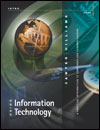 |  Using Information Technology Intro: A Practical Introduction to Computers and Communications, 5/e Stacey Sawyer
Brian K. Williams
SOCIETY & THE DIGITAL AGE: Challenges & Promises
Web Summary- The Digital Environment: Is There a Grand Design? Some factors affecting the shape of the digital environment are as follows. (1) The National Information Infrastructure is a grand design relying on private companies and the Internet. (2) The old Internet is being replaced by new Internet networks -- VBNS, Internet2, and the NGI. The VBNS is the main government component to upgrade the backbone, or primary hubs of data transmission. Internet2 is a cooperative university-business program to enable high-end users to quickly move data, using VBNS. The Next Generation Internet (NGI) is designed to help tie campus high-performance backbones to the federal infrastructure. (3) The 1996 Telecommunications Act was designed to increase competition between telecommunications businesses, so different companies are no longer restricted from offering different services. (4) The 1997 White House plan stresses that government should stay out of the way of Internet commerce. (5) ICANN is the Internet Corporation for Assigned Names and Numbers, which is a nonprofit corporation established to regulate Internet domain names.
- Security Issues: Threats to Computers & Communications Systems. Among the threats to the security of computers are the following. (1) Errors and accidents, such as human errors, procedural errors, software errors, electromechanical problems, and "dirty data" problems. (2) Natural hazards, such as earthquakes, hurricanes, and fires, and civil strife and terrorism. (3) Computer crimes, which can be either illegal acts perpetrated against computers or the use of computers to accomplish illegal acts. Crimes against computers include theft of hardware, software, time and services, or information, or crimes of malice and destruction. Crimes using computers include credit-card theft and investment fraud. (4) Worms, programs that copy themselves repeatedly into a computer's memory or disk drive, and viruses, deviant programs stored on hard drives that can destroy data. Worms and viruses are passed by exchange of infected floppy disks or infected data sent over a network; antivirus software can detect viruses. (5) Computer criminals may be an organization's employees, outside users, hackers and crackers, and professional criminals. Hackers gain unauthorized access to computers often just for the challenge, crackers for malicious purposes.
- Security: Safeguarding Computers & Communications. Security, the system of safeguards for protecting computers against disasters, failure, and unauthorized access, has four components. (1) Computer systems try to determine authorized users by three criteria: by what they have (keys, badges, signatures); by what they know (as with PINs, or personal identification numbers, and passwords, or special words or codes); and by who they are (as by physical traits, as determined perhaps through biometrics, the science of measuring individual body characteristics). (2) Encryption, altering data so it is not usable unless the changes are undone, tries to make computer messages more secure. (3) Software and data are protected by controlling access to files, by audit controls that track the programs used, and by people controls that screen job applicants and other users. (4) Disaster-recovery plans are methods for restoring computer operations after destruction or accident.
- Quality-of-Life Issues: The Environment, Mental Health, & the Workplace. Some quality-of-life issues related to information technology are as follows. (1) Computers may create environmental problems, such as putting a lot of telecommunications equipment in natural settings. (2) Computer-related mental-health problems include isolation, online gambling, and stress. (3) Problems affecting workplace productivity include misuse of technology, as when employees waste company time going online for personal purposes; fussing with computers because of hardware/software problems; and information overload.
- Economic Issues: Employment & the Haves/Have-Nots. Two charges by economic critics of information technology are as follows. (1) Technology replaces humans in countless tasks, for millions of workers into temporary or part-time employment or unemployment. (2) Technology widens the gap between rich and poor, between information "haves" and "have-nots."
- Artificial Intelligence. Artificial intelligence consists of technologies
used for developing machines to emulate human qualities, including the following:
(1) Robotics,
the development and study of machines that can perform work normally done
by people, has produced robots,
automatic devices that perform functions usually performed by people. (2)
Expert systems
are interactive computer programs used to solve problems normally requiring
the assistance of human experts. (3) Natural language processing
is the study of ways for computers to recognize and understand human language.
Artificial life is the study of "creatures" -- computer instructions, or pure information -- that, like live organisms, are created, replicate, evolve, and die. A-life raises the question of how we can know when computers can be said to possess "intelligence" or "self-awareness." One answer is suggested by the Turing test, in which a human judge converses by means of a computer terminal with two entities -- one a person, one a computer hidden in another location--to try to determine which seems to have the most human qualities. - The Promised Benefits of the Digital Age. The challenge of making sense
of vast stores of information is being addressed with intelligent agents,
programs that roam networks and compile data and perform work tasks on your
behalf. In education, students at all levels are finding computers helpful.
Their use in distance learning over the Internet is increasing. Other areas
which hold promise of benefits include: health; commerce & money; entertainment;
government & electronic democracy.
|
|




 2002 McGraw-Hill Higher Education
2002 McGraw-Hill Higher Education